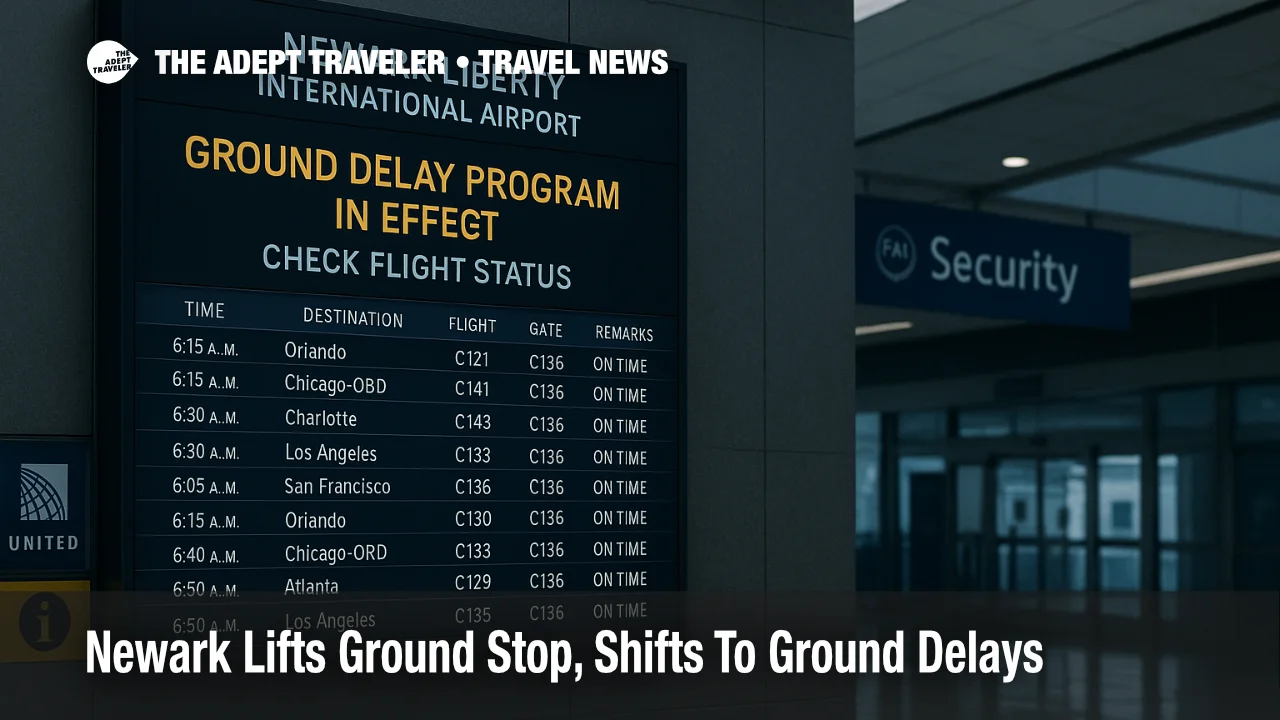Newark Lifts Ground Stop, Shifts To Ground Delays

Key points
- FAA issued a staffing-related ground stop at Newark from about 7:00 to 8:45 a.m. ET on November 2
- A Ground Delay Program replaced the stop with average arrival delays near two hours and a higher max
- Nationwide staffing shortfalls tied to the shutdown are driving rolling caps and program changes
- Travelers to or through Newark should expect revisions as FAA flow rates change through the day
Impact
- Who Is Affected
- Arriving and connecting passengers at Newark Liberty on Sunday, November 2, especially morning to early afternoon arrivals
- What To Expect
- Longer taxi-out holds at origin, inflight spacing, and gate holds as the Ground Delay Program meters arrivals
- How To Mitigate
- If you have a tight connection, ask your airline for protection on a later flight or a reroute via other New York airports
- Timing Notes
- The initial ground stop ended around 8:45 a.m. ET, with a Ground Delay Program active and subject to revision later today
- What We Are Watching
- FAA advisory updates and FlightAware delay metrics for changes to program duration or severity
A staffing-related ground stop briefly halted inbound flights to Newark Liberty International Airport (EWR) on Sunday morning, November 2, as the federal government shutdown continues to strain air traffic control staffing nationwide. The FAA transitioned Newark from a full stop to a Ground Delay Program by midmorning, extending arrival waits for many flights to roughly two hours, with higher maximums reported on individual routes.
After lifting the early ground stop, the FAA is metering Newark arrivals under a Ground Delay Program, meaning travelers should plan for extended inbound waits and potential connection risks as staffing dictates the airport's hourly arrival rate.
Newark status and today's delays
Local TV and FAA data indicate the ground stop at Newark ran approximately 700-845 a.m. ET. Once lifted, the FAA implemented a Ground Delay Program that reported an average inbound delay in the vicinity of 116 minutes and a maximum delay exceeding three hours on some flights, depending on origin and scheduled arrival bank. These figures can fluctuate as the FAA adjusts flow rates through the day.
FlightAware's live airport page and individual flight records show Newark arrivals being held at origin with roughly two-hour average delays late morning, consistent with a GDP. That, combined with typical Sunday hub traffic, raises the risk of missed connections and irregular operations for airlines with tight turnarounds.
The FAA's Current Operations Plan also listed Newark under an active Ground Delay Program window today, alongside other terminals facing weather or staffing constraints, underscoring that the Sunday program is planned and may be extended or canceled based on conditions.
Why this is happening
Nationwide, controller staffing has been under acute pressure during the October shutdown, now in its second month. FAA planning bulletins and national reporting describe increased controller absences and flow reductions to preserve safety. New York-area facilities have been among the hardest hit, with the agency slowing traffic to match available staffing.
This morning's Newark action follows a similar FAA staffing-triggered stop at EWR on October 29, when the agency halted arrivals, then shifted to a prolonged delay program. Such "stop, then delay" sequences are a common pattern when staffing dips below thresholds for complex airspace like the New York metro.
Background, how these programs work
A ground stop pauses certain departures bound for an airport, usually for a short window, until the constraint clears. A Ground Delay Program (GDP) meters inbound traffic by assigning controlled departure times at origin airports so that arrivals match a reduced acceptance rate at the destination. Both tools are managed by the FAA's Air Traffic Control System Command Center and can be revised multiple times per day for staffing, weather, or equipment reasons. Travelers experience GDPs as long "EDCT" holds before takeoff and, at times, additional airborne spacing on approach.
Practical advice
If you are booked to arrive at Newark today, build extra buffer for connections or onward ground transport. Check your airline app for a revised "EDCT" or "ATC delay" notice; if your connection time is under 90 minutes during a GDP, ask to be protected on a later flight or consider rerouting via John F. Kennedy or LaGuardia if seats are available. Monitor airline waivers and keep an eye on FAA advisories, which can ease or tighten arrival rates as staffing changes across shifts.
Final thoughts
Newark's morning ground stop has given way to a managed but slower arrival flow under a Ground Delay Program. With staffing still volatile, travelers headed into or through Newark on November 2 should expect continued schedule friction and check status often as the FAA updates constraints through the afternoon and evening.
Sources
- FAA Current Operations Plan Advisory - EWR Ground Delay Program details
- FAA National Airspace System Status - Active airport programs and delays
- FlightAware - Newark Liberty (EWR) live delays and GDP holds
- FOX 5 New York - "Staffing issues trigger ground stop at Newark on Sunday"
- Reuters - FAA says ATC staffing issues causing more flight delays during shutdown
- Politico - FAA warns of surge in controllers calling out during shutdown
- News 12 - FAA issues ground delays at tri-state airports due to staffing
- NBC New York - 'Staffing' issues force Newark Airport ground stop as shutdown wears on
- FOX Business - Major airports issue ground stops amid controller shortages
- FAA Newsroom - Extended limits on Newark operations for congestion management
